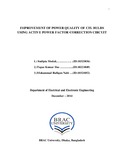Improvement of power quality of CFL bulbs using active power factor correction circuit
Abstract
Power electronics is a means of controlling/processing in an appropriate way that is suitable for the load. Power conditioning is done to ensure higher efficiency and power density. Improved efficiency can reduce emission of heat/wasted power so that it can reduces environmental pollution.
Power electronic converters use semi-conductor switching devices that are operated in ON-OFF states. These converters have higher efficiency with the control of distorted input signals. The input signal distortion increases with the increased use of these converters. Various standards have been set to limit the level of distortion. One of the ways of measuring these distortions is THD. A signal having THD more than the specified range has some detrimental effect on the line to which it is connected. Lighting loads are one of the major powering applications. Approximately 19% to 20% of the power is used for this purpose. As a result high efficient lighting system is a major research area in power electronics. In this regard incandescent bulbs were replaced by discharge lights (those are operated in negative resistance region) long ago. A ballast circuit is included to limit the current flow in this circuit. Initially magnetic ballasts were used. However due to some disadvantages like flickering, size, high cost, low efficiency etc electronic ballast has taken place instead of magnetic ballast.
The focus of this thesis is in the electronic ballasts in discharge lamps and the total harmonic distortion produced due to the non-linear circuit situated in the lamps. The main objective is to minimize this distortion as far as possible. Various simulations have been done in order to measure the total harmonic distortion of ballast circuit situated on the CFL bulb. Moreover a power factor rectification circuit has been provided to improve the power factor and reduce the THD value of the ballast circuit.

